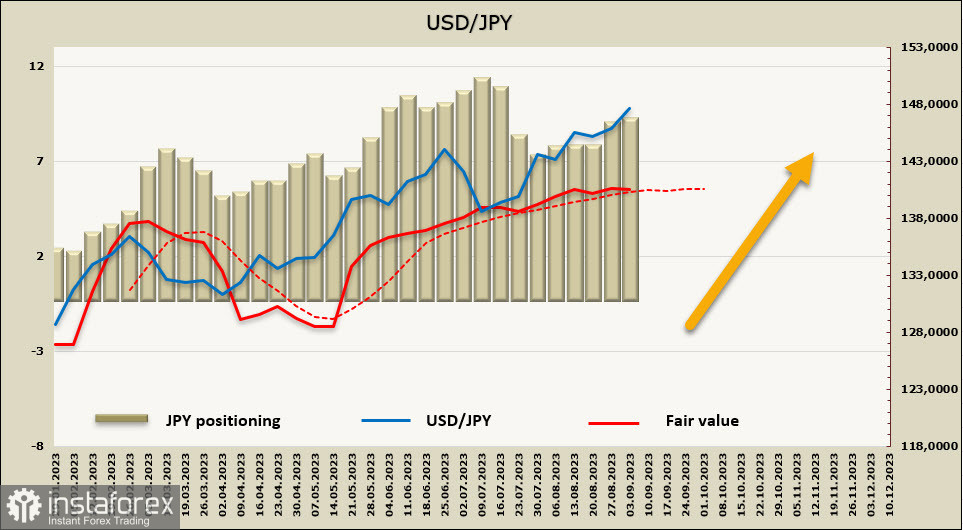Instead of declining, the US ISM Services PMI rose to 54.5 in August from 52.7 in July. The report recorded growth in all key parameters – employment, new orders, and even prices. Apparently, increased levels of consumer spending had become the main reason for the rise, but the question of whether consumer activity will remain high in the coming months remains debatable.
The US ISM data contrasts with the rest of the world, as similar gauges in China, the eurozone, and the UK, showed a decline, and the market interprets the results in favor of the US dollar. Take note that the final reading from S&P Global Business on the US services sector PMI was slightly lower than the preliminary one - 50.5 vs. 51.0, which sharply contradicts the ISM readings. This imbalance will be resolved next month.
The Federal Reserve's Beige Book showed that economic and labor market growth slowed in July and August, while many businesses expect wage growth to slow down in the near future. Here, too, we see a discrepancy with the ISM assessment, especially in light of the Fed's policy of restraining consumer demand as one of the key factors in inflation.
The GDPNow model estimate for real GDP growth by the Federal Reserve Bank of Atlanta in the third quarter of 2023 is 5.6 percent on September 6. Take note that this is a very high figure.

In summary, the general fundamental story suggests that the US is still a bit stronger compared to the rest of the world, and this will be the catalyst for the dollar strength, which remains the primary favorite in the currency market.
USD/CAD
As anticipated, the Bank of Canada held its key overnight interest rate unchanged at 5%. Therefore, changes in policy are deferred to the next meeting on October 26, where, among other things, forecasts will be updated.
In the accompanying statement for the July 12 meeting, it was stated that the rate was raised due to accumulation of evidence that excess demand and elevated core inflation have proved to be persistent. This time, the wording has been changed to a more neutral tone: "With recent evidence that excess demand in the economy is easing, and given the lagging effects of monetary policy...". This implies that the BoC believes that the measures taken earlier are yielding results and no changes are needed. Only time will tell whether this is really the case, but one thing is clear – the Canadian dollar has become more susceptible to further weakness. At least, concern about the persistently high core inflation was specifically emphasized.
At the moment, the probability of a rate hike in October is estimated at 25%, which is too little for a bullish revision of CAD forecasts.
The net short CAD position increased by 0.3 billion to -1.2 billion over the reporting week, indicating bearish positioning. The price is significantly above the long-term average, and there are no signs of a reversal.

USD/CAD continues to gradually rise. The pair has reached the nearest target that we mentioned in the previous review, and it appears that it will eventually test the upper band of the 1.3700/20 channel. It is likely for the pair to break above the channel, with 1.3857 as the medium-term target. From a technical perspective, after testing the upper band of the channel, we can expect a retracement towards the channel's midpoint. However, fundamental indicators suggest further growth.
USD/JPY
The rapid rise of the USD/JPY pair from below 145 to above 147.5 since the second half of last week triggered verbal intervention from Japanese authorities. Masato Kanda, vice minister of finance for international affairs, told reporters that "we won't rule out any options if speculative moves persist,".
Following this announcement, the USD/JPY pair dropped below 147.50 but eventually rose. The last time Japanese authorities intervened was in October 2022, to the tune of around 62 billion US dollars. If authorities resort to actual intervention, it could limit the USD/JPY's growth in the near future, but it won't change the general direction, as only fundamental reasons like exiting accommodative monetary policy can reverse the pair to the downside.
There's a low probability of such a move in the near term. On Wednesday, a member of the Bank of Japan's board, Takata, stated, "I believe the BoJ must patiently maintain easy policy given very high uncertainty on outlook," Currently, Japan has an ultra-loose monetary policy and the strongest macroeconomic performance in the Western world. Japan's Consumer Price Index is rising and exceeds the target (currently at 3.4% on an annual basis), but it will likely maintain its ultra-easy monetary policy, as it will take more than 12 months to combat structural deflation.
The net short JPY position increased by 0.2 billion over the reporting week, with the speculative bearish imbalance at -8.4 billion. Thus, positioning in the yen remains firmly bearish. The price is above the long-term average, but it lost the momentum, increasing the likelihood of a correction.

The yen has reached the upper band of the bullish channel, and is currently facing an uptrend, and there is no reason to doubt it. At the same time, the price has lost momentum, and in light of the verbal intervention from Japanese authorities, there's a high likelihood of a correction. If the uptrend resumes, the target will be the multi-year high of 151.96, but the closer it gets, the higher the probability of not just verbal but actual currency intervention. It's more likely that Japanese authorities won't allow a rapid yen depreciation, and in the event of intervention, a retreat to the broad support zone of 144/145 is not out of the question.
 English
English 
 Русский
Русский Bahasa Indonesia
Bahasa Indonesia Bahasa Malay
Bahasa Malay ไทย
ไทย Español
Español Deutsch
Deutsch Български
Български Français
Français Tiếng Việt
Tiếng Việt 中文
中文 বাংলা
বাংলা हिन्दी
हिन्दी Čeština
Čeština Українська
Українська Română
Română

